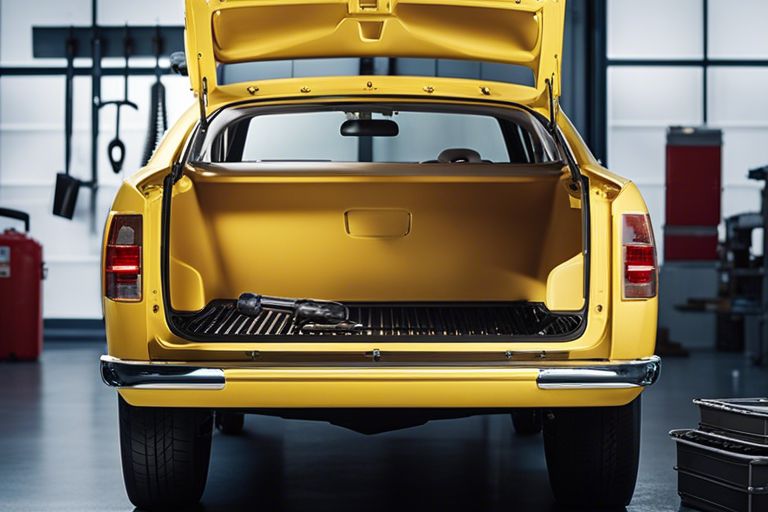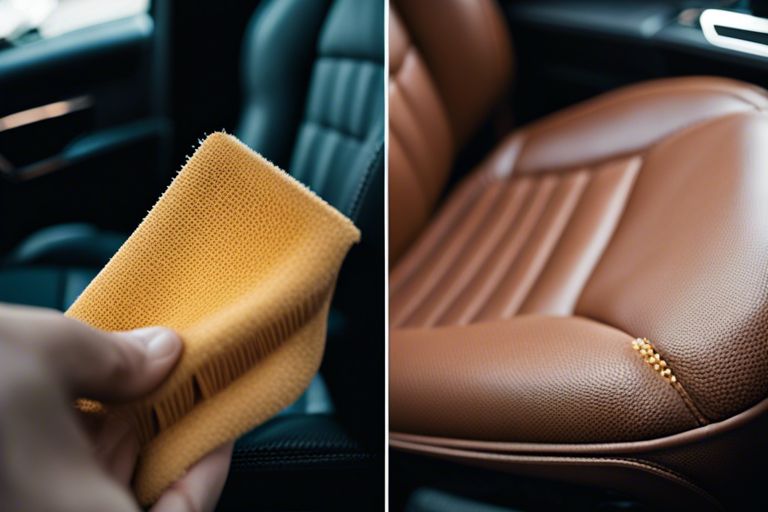Are you struggling with a dirty oil pan that’s causing issues with your vehicle’s performance? Cleaning your oil pan is an essential part of routine maintenance, and neglecting it can lead to serious problems. The accumulation of sludge and debris can restrict oil flow and potentially cause engine damage, so it’s crucial to keep it clean. In this informative blog post, you will learn step-by-step instructions on how to properly clean your oil pan, ensuring that your engine runs smoothly and efficiently. We’ll cover everything from preparing to disassemble the oil pan, cleaning the interior, to reassembling and reinstalling it. By the end of this post, you’ll have the knowledge and confidence to tackle this task on your own, saving you time and money.
Preparing to Clean the Oil Pan
Before you begin cleaning the oil pan, there are some important steps you need to take to ensure the process goes smoothly and safely. Preparing to clean the oil pan involves gathering necessary tools and materials, as well as taking safety measures and precautions.
Gathering Necessary Tools and Materials
When preparing to clean the oil pan, it’s crucial that you have all the necessary tools and materials on hand. This includes a wrench or socket set to remove the oil pan, a drain pan to catch the old oil, safety goggles and gloves to protect yourself from any spills or splashes, and cleaning materials such as degreaser, a brush, and rags. Make sure you have everything you need before you start the process to avoid any interruptions.
Safety Measures and Precautions
When working with oil, it’s essential to take safety measures and precautions to protect yourself and avoid accidents. Before you begin, make sure the engine has cooled down completely to avoid burns. Additionally, always use caution when working with hot oil to prevent burns or spills. It’s also a good idea to have a fire extinguisher nearby, just in case. Lastly, be mindful of the environment and dispose of the used oil and cleaning materials properly to avoid any harm to the surroundings.
Removing the Oil Pan
If you’re experiencing oil leaks or damage to your oil pan, it may be time to remove and clean it. This process requires some mechanical skill and the right tools, but it’s definitely doable. Here’s a step-by-step guide on how to remove the oil pan from your vehicle.
Draining the Oil
Before you can remove the oil pan, you’ll need to drain the oil from your vehicle. Start by placing a drain pan underneath the oil pan and then loosen the drain plug to allow the old oil to flow out. Be sure to wear gloves and goggles to protect yourself from hot oil splashes. Once the oil has completely drained, you can tighten the drain plug back in place.
Detaching the Oil Pan
After draining the oil, the next step is to detach the oil pan from the engine. First, you’ll need to locate and remove all the bolts that are holding the oil pan in place. This can be a bit tricky, so make sure you have the right tools for the job. Once all the bolts are removed, carefully detach the oil pan from the engine. Be prepared for some residual oil to spill out as you remove the pan. Be cautious as the oil could be hot and the pan may be heavy, so use proper lifting technique to avoid injury.

Cleaning the Oil Pan
Your oil pan can accumulate a buildup of sludge and debris over time. It’s important to regularly clean your oil pan to ensure it functions properly and to prevent any potential damage to your engine.
When it comes to cleaning your oil pan, it’s essential to use the right techniques and tools to get the job done effectively. Here are some tips to help you clean your oil pan thoroughly and efficiently.
Cleaning Techniques
One of the best ways to clean an oil pan is by using a degreaser to break down the oil and grime. You can then use a brush or rag to scrub away the loosened debris. For stubborn buildup, consider using a putty knife to carefully scrape away the residue. For more in-depth discussion on cleaning techniques, check out Best Way to Clean an Oil Drip Tray? – Maintenance/Repairs.
Troubleshooting Common Issues
If you encounter stubborn buildup that won’t easily come off, you may need to let the degreaser sit for a longer period or use a stronger solution. Additionally, if you notice any cracks or damage to the oil pan during cleaning, it’s imperative to address these issues promptly to avoid potential leaks or further damage to your engine. It’s important to maintain a thorough and regular cleaning routine for your oil pan to ensure the longevity and optimal performance of your vehicle.
Reinstalling the Oil Pan
To reinstall the oil pan, start by applying a thin bead of RTV silicone sealant to the pan mounting surface. Gently place the clean oil pan back onto the engine and hand-tighten the mounting bolts. Refer to the manufacturer’s specifications for the torque requirements and use a torque wrench to tighten the bolts to the specified foot-pounds. For specific tips and tricks on properly reinstalling an oil pan, you can check out this forum discussion on the best way to clean an oil pan?.
Ensuring a Proper Seal
After reinstalling the oil pan, it’s crucial to ensure a proper seal to prevent oil leaks. Allow the RTV silicone sealant to cure according to the manufacturer’s instructions before adding fresh oil. Inspect the perimeter of the oil pan to make sure the sealant is uniformly compressed. Double-check the torque of the mounting bolts to make sure they are secure. A proper seal is essential to prevent oil from leaking out and causing damage to your engine.
Refilling Oil and Final Checks
Once the oil pan is reinstalled and properly sealed, you can begin refilling the engine with fresh oil. Use the recommended oil weight and viscosity for your vehicle and fill the engine to the proper level. Start the engine and check for any signs of oil leaks around the oil pan. Additionally, inspect the oil drain plug and filter housing for leaks. Finally, check the oil level on the dipstick to ensure it’s at the correct level. Your diligence in refilling oil and performing final checks will ensure the continued health and performance of your engine.
Maintenance Tips
Now that you’ve effectively cleaned your oil pan, it’s important to take some preventative measures to ensure it stays clean and functioning properly. Here are a few maintenance tips to keep in mind:
- Regularly check and clean the oil drain to prevent build-up and clogging. For more in-depth information, check out 8 Tips of Cleaning Oil Drain Pan After Oil Change
Assume that your oil pan will need regular maintenance to prevent costly issues down the road.
Regular Check-Ups
Regularly check and clean the oil drain to prevent any build-up and potential clogging. This may include removing the drain plug and thoroughly cleaning it, as well as inspecting the drain pan for any accumulated debris. This simple task can prevent major issues and ensure the longevity of your oil pan.
Preventative Measures
To prevent the build-up of sludge and debris in your oil pan, consider adding an oil pan magnet or using high-quality oil filters. Additionally, sticking to a regular oil change schedule can prevent sludge and debris from accumulating in the first place. Taking these preventative measures will ensure the continued efficiency and durability of your oil pan.

Conclusion
So now that you know how to clean your oil pan, you can ensure that your vehicle continues to run smoothly and efficiently. By following these steps, you can remove built-up sludge and debris, preventing potential damage to your engine and oil system. Regularly cleaning your oil pan is an important part of maintaining your vehicle’s overall health and longevity, and with these simple steps, you can easily keep it in top condition. Remember to always use caution and follow safety guidelines when working with hot oil and engine components, and keep up with regular maintenance to keep your car running at its best.
FAQ
Q: Why is it important to clean the oil pan?
A: Cleaning the oil pan is important to remove sludge, debris, and metal shavings that can accumulate over time. This helps maintain proper oil circulation and prevents engine damage.
Q: What tools do I need to clean the oil pan?
A: You will need a wrench, oil drain pan, gasket scraper, solvent or degreaser, and rags for cleaning.
Q: How often should I clean the oil pan?
A: It is recommended to clean the oil pan every time you change the oil, typically every 3,000 to 5,000 miles. However, if you notice excessive sludge buildup, it may need to be cleaned more frequently.
Q: Can I clean the oil pan without removing it?
A: While it is possible to clean the oil pan without removing it, it is not recommended. Removing the oil pan allows for thorough cleaning and inspection for any signs of damage or excessive wear.
Q: What is the best way to clean the oil pan?
A: The best way to clean the oil pan is to first drain the oil, remove the oil pan, and then use a gasket scraper to remove any old gasket material. Next, use a solvent or degreaser to clean the inside of the pan, and wipe it dry with clean rags before reinstalling.
- How to Diagnose Bad Strut Mounts: Expert Tips for Quick Fixes - May 16, 2024
- How to Bypass Blower Motor Relay: 7 Expert Techniques - May 16, 2024
- How to Easily Check Ecu Ground: Essential Steps for Optimal Performance - May 16, 2024



